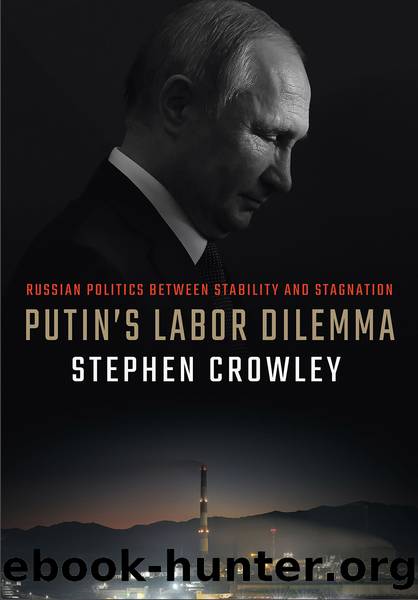Putin's Labor Dilemma: Russian Politics Between Stability and Stagnation by Stephen Crowley

Author:Stephen Crowley [Crowley, Stephen]
Language: eng
Format: epub
Tags: law, Labor & Employment, Political Science, World, Russian & Former Soviet Union, History, Russia & the Former Soviet Union
ISBN: 9781501756290
Google: Ky39DwAAQBAJ
Publisher: Cornell
Published: 2021-07-15T14:02:33+00:00
Defending Stability in Tough Times
Putin came to power in 1999 as the prime minister serving a deeply unpopular President Yeltsin. While Yeltsin survived the wave of protests in the late 1990s, the entire Yeltsin government and entourage were, in the publicâs mind, deeply implicated in the cataclysm of the 1990s, especially the huge increase in poverty and the rapid privatization that was widely viewed as enriching a handful of oligarchs. When Putin assumed the presidency in early 2000, many observers believed he was given the post in order to protect the Yeltsin âfamilyââthose most closely associated with Yeltsin, including powerful oligarchsâfrom prosecution and possible loss of their assets.
As president, Putin soon made the promise of âstability,â in contrast to the chaos of the 1990s, a cornerstone of his claim to legitimacy.1 The perceived threats to that stability began early on. Already in 1999, the NATO bombing of Russiaâs longtime ally Serbia outraged even pro-Western liberals in Russia.2 That action directly contributed to the overthrow of Slobodan MiloÅ¡eviÄ the following year, in the first of the color revolutions. For Russiaâs new leadership, this suggested a twofold threat to stability: an external threat, from Western governments seeking âregime change,â and an internal threat, in that foreign influences sought to provoke domestic populations into rising up against their own governments. The âBulldozer Revolutionâ in Serbia was soon followed by the âRose Revolutionâ in Georgia in 2003, the âOrange Revolutionâ in Ukraine in 2004, and the âTulip Revolutionâ in Kyrgyzstan in 2005.
For the leaders of Russia and other post-Soviet states, witnessing governments in neighboring countries fall through mass protest was hardly a welcome experience. Thus, what has been described as the âcreeping authoritarianismâ of Putinâs presidency did not take place in a vacuum. Russian (and other post-Soviet) leaders began to engage in âpreemptive authoritarianism,â seeking to eliminate threats before they arose.3 Putinâs government enacted restrictive electoral reforms in 2005 and a law to curtail NGOs in 2006. The Russian leadership created its own youth movement, Nashi, to counter the youth movements that were seen as driving the color revolutions in other countries. With such concerns in mind, Kremlin leaders began overtly to question the legitimacy of liberal democracy, alleging that it was a foreign influence alien to Russian culture.4
Given such anxieties over foreign intervention and youth-led protests, any threat from workers would appear to be a lower-level concern. As we have seen, however, the challenge posed by workers began before Putin came to power and predated any concern with color revolutions. By the mid-1990s, it was clear that the nonpayment of wages and the resulting protests reflected the failure of trade unions or other institutions to effectively channel the grievances of workers and others in a time of wrenching social change. As Simon Clarke noted at that time, this âunderlies the dual fear that the bulk of the population will, in its passive moment, vote for the authoritarian leader who can make the most radical promises and, in its active moment, take to the streets in outbursts of mass civil unrest.
Download
This site does not store any files on its server. We only index and link to content provided by other sites. Please contact the content providers to delete copyright contents if any and email us, we'll remove relevant links or contents immediately.
The Social Psychology of Inequality by Unknown(2936)
The Plant Paradox by Dr. Steven R. Gundry M.D(2543)
The Writing on the Wall by Anselm Jappe(2009)
Working for Yourself by J.D. (Nolo) Stephen Fishman(1815)
Every Landlord's Legal Guide by Janet Portman & Stewart Marcia & Ralph Warner(1628)
The First 20 Hours: How to Learn Anything ... Fast by Kaufman Josh(1615)
ADHD on Trial by Michael Gordon(1531)
Decisive by Chip Heath(1514)
Working for Yourself by Stephen Fishman J.D. (Nolo)(1476)
Drafting Contracts: How and Why Lawyers Do What They Do, Second Edition by Stark Tina L(1456)
A Practical Guide to International Arbitration in London by Hilary Heilbron(1394)
Restitution by Restitution(1393)
The Economist Aug 8th 2015 by The Economist(1384)
Intellectual Property Strategy by John Palfrey(1384)
The Lord of the Rings: The Fellowship of the Ring, the Two Towers, the Return of the King by J. R. R. Tolkien(1382)
Get What's Yours for Medicare by Philip Moeller(1362)
The Economist Aug 29th 2015 by The Economist(1342)
Collusion by Luke Harding(1281)
Persuasion by Owner(1266)
